|
|
Boomer Diet
Boomer Diet – together with exercise - is the other key component of our formula for a healthy lifestyle. In fact, it’s often estimated that 75% of fitness is proper diet. So how hard can it be – we all know how to eat, right? It’s a piece of cake…
Well, that sort of thinking, and too many pieces of cake, can be our own worst enemies. Do we even know what we're eating? When was the last time we thought about the basic food groups – beyond the one we know is chocolate? How many calories do we consume each day? How many do we need?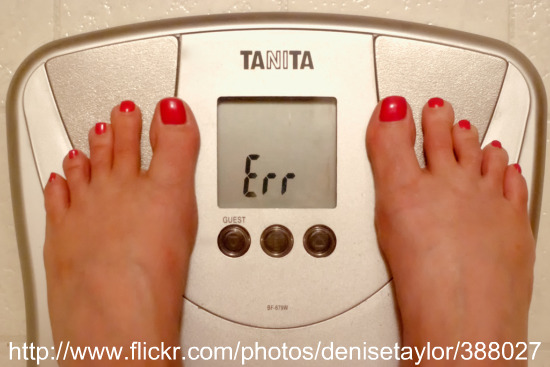 Are carbohydrates good for us or not? And what’s the difference between good fats and bad fats? Are carbohydrates good for us or not? And what’s the difference between good fats and bad fats?
A good boomer diet means bon- ing up on questions like these plus a few others. But a good boomer diet will be different for each of us – based upon such variables as age, gender, body type, health conditions, and activity level – and so it’s not our point here to prescribe any particular diet to anyone. That advice should only come from our doctor, based upon individual needs and circumstances.
But we can make that conversation with our doctor much more meaningful, just by understanding the basics for a good boomer diet and knowing what we eat. Much like exercise (scroll over to Boomer Exercise), the keys to proper boomer diet include knowledge, making good choices, and commitment.
Boomer Diet – Glossary
There is never a shortage of technical terms, but it helps our boomer diet discussion to define a few basic terms that we might have forgotten from our school days in science class:
- Carbohydrates – neutral compounds of carbon, hydrogen, and oxygen, that are converted into sugars, starches, and cellulose through the process of photosynthesis; it’s one of three macro-nutrients that provide energy for the body (protein and fats are the other two). The three broad categories of carbohydrates are:
- Simple carbohydrates – aka sugars -
 exist in either a natural form (in fruits and vegetables) or refined form (in biscuits, cakes, pastries, chocolate, honey, jams, jellies, brown and white cane sugar, pizzas, prepared foods and sauces, soft drinks, candy and snack bars). exist in either a natural form (in fruits and vegetables) or refined form (in biscuits, cakes, pastries, chocolate, honey, jams, jellies, brown and white cane sugar, pizzas, prepared foods and sauces, soft drinks, candy and snack bars).
- Complex Carbohydrates – aka starches – exist mostly in natural form (in bananas, barley, beans, brown rice, chickpeas, lentils, nuts, oats, parsnips, potatoes, root vegetables, sweet corn, whole grain cereals, whole meal breads, whole meal cereals, whole meal flour, whole meal pasta and yams).
- Fiber - the indigestible part of plant foods in- cluding fruits, vegetables, whole grains, nuts, and legumes (there is no fiber in animal prod- ucts such as milk and other dairy products, eggs, meat, poultry, and fish); when dietary fiber is consumed, most of it passes through the intestines and is not digested.
- Fats - organic compounds of carbon, hydrogen, and oxygen belonging to a group of substances called lipids, in liquid or solid form; fats are one of the three macro-nutrients that provide the body with energy (proteins and carbohydrates are the other two); all fats are a combination of saturated and unsaturated fatty acids:
- Hydrogenated fats - oils that have become hardened, such as hard butter and margarine (best to avoid foods made with hydrogenated oils because they contain high levels of trans fatty acids which are linked to heart disease).
- Saturated fats (so named because every carbon atom is completely saturated with all the hydrogen that it can possibly carry) - the main dietary cause of high blood cholesterol, found mostly in foods from animals (e.g., beef, beef fat, veal, lamb, pork, lard, poultry fat, butter, cream, milk, cheeses and other dairy products made from whole and 2 percent milk) and some plants (e.g., coconut, coconut oil, palm oil and palm kernel oil - often called tropical oils - and cocoa butter).
- Trans fats – aka partially hydrogenated oils – artificially produced to extend shelf life by adding hydrogen to liquid vegetable oils to make them more solid, and are found in fried foods, commercial baked goods (donuts, cookies, crackers), processed foods, and margarine; trans fats can raise LDL levels (“bad” cholesterol), lower HDL levels ("good” cholesterol) and block the essential use of fatty acids in our body cells.
- Unsaturated fats – aka polyunsaturated fats (both are so named because many of the carbon atoms are empty and without any hydrogen) - fats that help to lower blood cholesterol if used in place of saturated fats, yet high in calories; most but not all liquid vegetable oils are unsaturated (exceptions include coconut, palm, and palm kernel oils) and have a short shelf life.
- Glycemic Index - a method of measuring blood sugar levels with respect to carbohydrate consumption, measuring how much and how quickly the blood sugar level increases; foods containing carbohydrates are measured on a scale of 1 to 100, giving each food its own glycemic index value. Foods with a high glycemic index (70 or higher) such as white bread, cause rapid spikes in blood sugar, while foods with a low glycemic index (55 or less) such as whole oats, are digested more slowly, causing a lower and gentler change in blood sugar.
- Proteins - strings of amino acids that form chains known as peptides, and are one of the three macro-nutrients that provide the body with energy (fats and carbohydrates are the other two). Protein is needed to accomplish many basic functions in the body, such as building bones, moving muscles, and repairing tissue, and is found in meat, dairy, certain grains and beans.
Boomer Diet – Good Things to Do
 Healthy foods and nutrition are important at any age, and a proper boomer diet is especially key as we reach our 40s and 50s. We know we start to lose muscle mass after age 40 – at the rate of ½ pound of muscle mass per year – which in turn makes way for weight gain. We also become more vulnerable to age-related illness such as heart disease, stroke, high blood pressure, diabetes, arthritis, and osteoporosis. Healthy foods and nutrition are important at any age, and a proper boomer diet is especially key as we reach our 40s and 50s. We know we start to lose muscle mass after age 40 – at the rate of ½ pound of muscle mass per year – which in turn makes way for weight gain. We also become more vulnerable to age-related illness such as heart disease, stroke, high blood pressure, diabetes, arthritis, and osteoporosis.
But on the other hand, eating is one of our greatest pleasures, not to mention the pride that a lot of us take in preparing great meals. So is this a dilemma? No, not really – at least it doesn’t have to be.
We can still keep our pleasure and our pride, just be keeping our boomer diet within the following parameters.
Boomer Diet - Know the Basic Food Groups
With everything we see online, on TV, in newspapers and magazines about healthy eating, it's easy to get lost in all the clutter. A good starting point for a boomer diet is simply knowing the basic food groups: 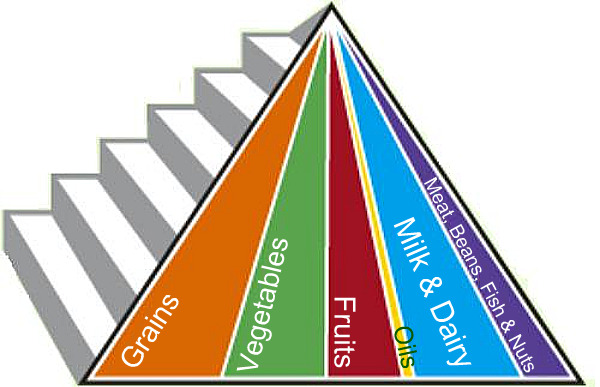
- Grain Group - any food made from wheat, rice, oats, cornmeal, barley or another cereal grain, such as enriched whole grain bread, rolls, English muffins, bagels, pasta, oatmeal, breakfast cereals, tortillas, and grits.
Grains are classified as either whole grains (containing the entire grain kernel, including the bran, germ, and endosperm) or refined grains (have been milled to remove the bran and germ, giving the grain a finer texture and longer shelf life, but also removing dietary fiber, iron, and many B vitamins). Most refined grains are enriched, meaning certain B vitamins (thiamine, riboflavin, niacin, folic acid) and iron are added back in after processing. But since fiber is not added back in, it’s best to check the ingredient list on refined grain products to see if the word “enriched” is included in the grain name. Some food products are made from combining whole grains and refined grains..
- Vegetable Group - any vegetable or 100% vegetable juice, whether raw, cooked, fresh, frozen, canned, dried/dehydrated, whole, cut-up, or mashed.
Vegetables are organized into five subgroups, based on their nutrient content: Dark Green (lettuce, broccoli, spinach, turnip greens, bok choy and watercress); Orange (carrots, squash, sweet potatoes and pumpkin); Dry beans and Peas, Starchy vegetables 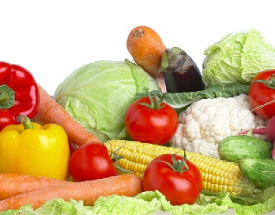 (corn, green peas, lima beans and pota- toes) and Other (artichokes, asparagus, bean sprouts, beets, Brussels sprouts, cab- bage, cauliflower, celery, cucumbers, egg- plant, green beans, green or red peppers, ice- berg lettuce, mushrooms, okra, onions, par- snips, tomatoes, tomato juice, vegetable juice, turnips, wax beans and zucchini). (corn, green peas, lima beans and pota- toes) and Other (artichokes, asparagus, bean sprouts, beets, Brussels sprouts, cab- bage, cauliflower, celery, cucumbers, egg- plant, green beans, green or red peppers, ice- berg lettuce, mushrooms, okra, onions, par- snips, tomatoes, tomato juice, vegetable juice, turnips, wax beans and zucchini).
- Fruit Group - any fruit or 100% fruit juice, whether fresh, canned, frozen, dried, whole, cut-up, or pureed.
Common fruits include apples, apricots, avocados bananas, berries, cherries, citrus fruits, dates, grapes, kiwi fruit, melons, fruit cocktail, nectarines, peaches, pears, pineapples, plums, papaya, prunes, raisins, unsweetened dried fruits and 100% fruit juices.
- Oils Group - fats that are liquid at room temperature, like the vegetable oils used in cooking (e.g., canola oil, cottonseed oil, olive oil, safflower oil, soybean oil and sunflower oil) and originating from plants and fish. Foods that are naturally high in oils include nuts, avocados, olives and certain fish.
Foods such as mayonnaise, certain salad dressings, and soft (tub or squeeze) margarine with no trans fats are mostly oils. Most oils are high in monounsaturated or polyunsaturated fats, and low in saturated fats. Foods and oils originating from plant sources (vegetable and nut oils) never contain any cholesterol.
- Milk Group - fluid milk and products made from milk that retain their calcium content, including hard and soft cheeses, puddings, cottage cheese, yogurt and ice cream, but excluding milk products that have little or no calcium, such as cream cheese, cream, and butter.
- Meat and Beans Group - all foods made from meat (e.g., beef, ham, pork, veal, lamb, liver, giblets, venison, rabbit and bison), poultry (e.g., chicken, turkey, duck and goose), fish (various fin fishes, shellfishes, and canned fishes (such as tuna, clams, anchovies and sardines), various dry beans and peas (which also belong to the vegetable group), eggs, nuts, and seeds.
Boomer Diet – Know a Serving Size
 When we were growing up, a serving size was whatever portion mom or dad put on our plates for supper each night. Ever since, it’s probably been whatever size we feel like eating, or even worse, whatever size we’re being served at the restaurant or drive-thru. But now that we’re reading the labels on all the foods that go into our boomer diet, it’s important to know what the serving sizes equate to. When we were growing up, a serving size was whatever portion mom or dad put on our plates for supper each night. Ever since, it’s probably been whatever size we feel like eating, or even worse, whatever size we’re being served at the restaurant or drive-thru. But now that we’re reading the labels on all the foods that go into our boomer diet, it’s important to know what the serving sizes equate to.
Some serving size equivalents from each food group:
- Grain Group - generally, a one ounce equivalent = 1 slice of bread, or 1 cup of ready-to-eat cereal, or ½ cup of cooked rice, cooked pasta, or cooked cereal, or ¼ bagel, or 1 small muffin, or ½ English muffin or 1 pancake.
- Vegetable Group - generally, 1 cup = 1 cup of raw or cooked vegetables or vegetable juice, or 2 cups of raw leafy.
- Fruit group – generally, 1 cup = 1 cup of fruit or 100% fruit juice, or ½ cup of dried fruit, or 1 banana, or 1 small apple, or 1 pear, or 1 orange or ½ grapefruit.
- Oils Group – 1 tbsp of vegetable oil = 3 T of oil, 1 tbsp of margarine or mayonnaise = 2 ½ T of oil, 2 tbsp of Italian dressing = 2 T of oil, 2 T of peanut butter = 4 T of oil, and 1 ounce of mixed nuts = 3 T of oil.
- Milk Group - generally, 1 cup = 1 cup of milk or yogurt, or 1 ½ ounces of natural cheese, or 2 ounces of processed cheese, or 2 cups of cottage cheese, or 1 cup of pudding, or 1 cup of frozen yogurt, or 1 ½ cups of ice cream.
- Meat and Beans Group – generally, 1 ounce = 1 ounce of meat, poultry or fish, or ¼ cup cooked dry beans, or 1 egg, or 1 tablespoon of peanut butter, or ½ ounce of nuts or seeds or 1 can of tuna fish.
Boomer Diet – Good Things vs. Bad Things
Like so many other things in life, there are good sides and bad sides to the various fats, carbohydrates and proteins that we eat. While it’s nearly impossible – and impractical – to avoid every bad thing in our boomer diet, it’s essential that we can tell the good from the bad, and that the good stuff “outweigh” the bad.
- Carbohydrates – generally speaking, complex carbohydrates are the “good carbs” because it takes our bodies longer to break the sugars down and use them. Because this process is extended, we get lower amounts of sugars released into the bloodstream, and the release comes at a slower rate. As a result, we get a more consistent supply of energy throughout our day, avoiding the peaks and valleys.
- Complex (good) carbs come from whole grain breads and cereals, starchy vegetables and legumes, and provide vitamins, minerals and fiber. Good carbs make us feel fuller and hence less likely to overeat.
- Simple carbohydrates for the most part are the “bad carbs” because they are released more quickly into the bloodstream, are higher in sugar, lower in fiber and have little nutritional value. Although some fruits and vegetable are classified as simple carbohydrates, they also contain natural vitamins and nutrients, plus fiber that slows the sugar absorption process, hence fruits and vegetables fall on the “good” side.
- Simple (bad) carbs include sugars added during food processing and refining, such as brown sugar, corn sweetener, corn syrup, dextrose, fructose, fruit juice concentrates, glucose, high fructose corn syrup, honey, lactose, maltose, malt syrup, molasses, raw sugar, refined sugar, sucrose and syrup. Simple carbs give us that “sugar high”, followed by the crash.
- Fats – ironic as it may seem, eating fat is a necessary part of our boomer diet, insofar as fats, i.e., the “good fats”, provide fatty acids which are essential for controlling inflammation, blood clotting and brain development. Since fatty acids are not made by the body, we can only get them from the food we eat.
- Good fats are those
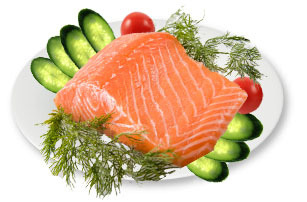 that are unsaturated, or poly- unsaturated, or mono-un- saturated, because the molecules of these fats are larger and do not tend to bond together, thereby producing little or no plaque build-up in our arteries. Olive oil is un- saturated and contains a beneficial fatty acid (oleic acid); omega-3 fatty acids are also unsaturated and are found in fatty fish such as salmon and mackerel that are unsaturated, or poly- unsaturated, or mono-un- saturated, because the molecules of these fats are larger and do not tend to bond together, thereby producing little or no plaque build-up in our arteries. Olive oil is un- saturated and contains a beneficial fatty acid (oleic acid); omega-3 fatty acids are also unsaturated and are found in fatty fish such as salmon and mackerel
- Bad fats are those that are saturated or hydrogenated (includes trans fats), because the molecules of these fats do have a bonding tendency in the bloodstream, causing plaque build-up in the arteries. For a healthy boomer diet, most nutritionists recommend avoiding trans fats and hydrogenated fats altogether, and limiting saturated fats to less than 30% of our daily calorie intake.
- Protein – unlike carbs and fats, protein is not categorized as good or bad, but rather as being “complete” or “incomplete”. A complete source of protein (aka high quality protein) contains all of the 20 essential amino acids which our bodies need each day, to replace that which is used in every cell, tissue and organ. An incomplete source of protein is low on one or more of the essential amino acids (two or more “incomplete” protein sources that together would provide all 20 essential amino acids would be categorized as “complementary”).
Boomer Diet - Reading Nutrition Labels
The US Food and Drug Administration (USDA) requires that all food packages contain a standard listing known as Nutrition Facts, providing the following information:
- Serving size
- Number of servings in each package
- Number of calories per serving (including how many calories from fat)
- Quantities (in grams or milligrams) for each nutrient (fats, carbs, protein, vitamins and minerals) contained in one serving
- Recommended daily values for fats, cholesterol, and sodium (maximum intakes) and for carbohydrates and dietary fiber (minimum intakes)
Once we know the serving sizes and how many we should have each day, we just need to read some labels and compare products and brands to see our best choices for getting a balanced boomer diet. 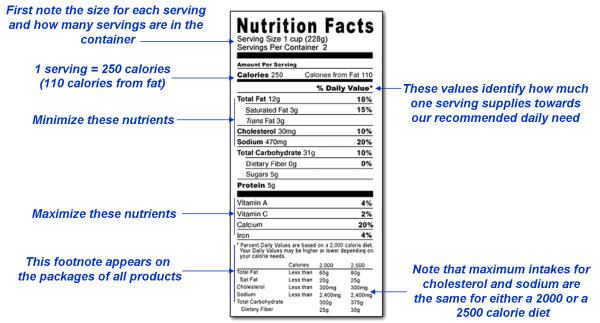 Some key points to remember in reading the nutrition labels:
- Compare the serving size of the product to the quantity you would normally consume. For example, if you were to eat two servings of the product shown above, you would consume double the quantities of everything listed on the label, i.e., 500 calories (220 calories from fat), 24 grams of fat, 60 milligrams of cholesterol, 940 milligrams of sodium, 10 grams of sugars and 10 grams of protein (double each of the % Daily Values as well).
- Based on a diet of 2000 calories/day, 40 calories would be considered low, 100 calories would be moderate and 400 calories or more would be high.
- Limit total fat intake to 20-35% of total calories per day (can approach 35% if most are “good” fats, such as fish, nuts, and vegetable oils containing polyunsaturated and mono-unsaturated fatty acids; lean, low-fat or fat-free meats, poultry, dry beans and dairy products are preferable).
- Limit the intake of saturated fatty acids to less than 10% of calories consumed per day.
- Avoid trans fatty acids found in fried foods, commercial baked goods (such as donuts, cookies and crackers), in processed foods, and in margarine.
- Limit cholesterol intake to less than 300 mg per day.
- Limit sodium intake to 2300 mg or less per day.
- Limit carbohydrate intake to 15% of total calorie intake per day.
- Men 50+ should consume at least 30 grams of fiber daily (women 50+ should consume at least 21 grams).
- Avoid added sugars.
- Men 50+ should consume 56 grams of protein daily (women 50+ should consume 46 grams).
- Pay particular attention to the % values listed for vitamins, calcium and minerals to be certain you are getting enough each day.
- Read the list of ingredients at the
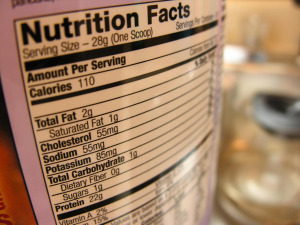 bottom of the label (listed in descending order of quan- tities) and avoid such things as: bottom of the label (listed in descending order of quan- tities) and avoid such things as:
- High Fructose Corn Syrup (HFCS) - a manufactured sugar found to promote hunger cravings and spikes in blood sugar levels
- Hydrogenated fat – contains fatty acids which increase cholesterol levels in the bloodstream
- Aspartame – an artificial sweetener that may promote cravings for high calorie foods and carbohydrates
- White sugar, aka refined sugars – intensively processed to remove all vitamins, minerals, enzymes and fiber, but high in calories; studies link refined sugars to hyperactivity, attention disorders, mental disorders, hypoglycemia and a weakened immune system
- White flour – intensively processed to extend shelf life but loses virtually all nutritional content, yet high in calories; also spikes blood sugar levels that lead to food cravings
Additional tips to insure a balanced boomer diet:
- Drink 3 cups of fat-free or low-fat milk or milk products per day.
- Eat 2 cups (4 servings) of fruit and 2.5 cups (5 servings) of vegetables per day for an average 2000 calorie/day diet.
- Eat 3 ounces or more of whole grain products per day.
- Limit consumption of alcohol (maximum 1 drink/day for women and 2 drinks/day for men).
- Balance your boomer diet with exercise, i.e., slowly decrease your calorie intake while increasing your exercise and activity levels to avoid weight gain over time.
Boomer Diet – Vitamins and Minerals
We know that vitamins and minerals are important for a healthy boomer diet. As micro-nutrients (remember that fats, carbs and protein are macro-nutrients), vitamins and essential minerals are needed to assist normal growth, digestion, mental alertness and resistance to infection. They also act as catalysts in our body, starting or accelerating a chemical reaction by assisting the enzymes that release energy from carbohydrates, proteins and fats.
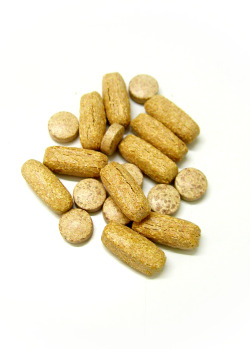 However, we can’t "burn" vitamins like we do the calories we get from fats, carbs and protein; we can't get energy directly from them. Hence, any labels we might read for “miracle energy” vitamin supplements are greatly exaggerated. However, we can’t "burn" vitamins like we do the calories we get from fats, carbs and protein; we can't get energy directly from them. Hence, any labels we might read for “miracle energy” vitamin supplements are greatly exaggerated.
Our body can not make most of the vitamins and minerals we need, so we must get them from food or supplements (pills). Clearly, our best source comes from the food we eat in a balanced boomer diet – not only does nature trump anything we manufacture in a bottle, research is a bit mixed as to how beneficial or necessary taking supplements actually is.
Of the 13 vitamins, four are fat soluble (A,D and K) and stored in certain organs like the liver; nine are water soluble (C and the eight “B” vitamins) and are stored in small amounts for temporary periods before excretion through the urine. Because they're stored in our body tissues, excess fat-soluble vitamins can accumulate and become toxic (the body is especially sensitive to too much vitamin A and D).
Questions of how many vitamins, and how much of each we need, depends upon such variables as age, health and nutritional status, and are still debated among doctors and scientists. Over recent decades, minimum daily allowances have evolved (and increased) to the % Daily Values (DVs) that we now see on the Nutrition Facts labels on all food packaging.
There are 15 minerals that help regulate cell function and provide structure for cells in the body (primary needs are calcium, phosphorus and magnesium). Our body needs smaller amounts of chromium, copper, fluoride, iodine, iron, manganese, molybdenum, selenium, zinc, chloride, potassium and sodium; however, excessive amounts can also be toxic.
Vitamin and mineral supplements should never be a substitute for a healthy boomer diet. We can never justify poor eating habits and choices simply by thinking, “Well, it’s OK because I’m still getting my vitamins and minerals (from a bottle).” Research indicates there's probably no harm in taking a multiple vitamin-mineral supplement, as long as the dosing levels are no higher than 100 percent of the Daily Value (higher doses don't give extra protection, but do increase the risk of toxic side effects).
Ultimately, we should ask our doctor if vitamin and mineral supplements are best for our boomer diet, based upon evaluating our own particular circumstances.
Return from Boomer Diet to Boomer Health
Return from Boomer Diet to Baby Boomers R We
|
|
 Are carbohydrates good for us or not? And what’s the difference between good fats and bad fats?
Are carbohydrates good for us or not? And what’s the difference between good fats and bad fats?
 exist in either a natural form (in fruits and vegetables) or refined form (in biscuits, cakes, pastries, chocolate, honey, jams, jellies, brown and white cane sugar, pizzas, prepared foods and sauces, soft drinks, candy and snack bars).
exist in either a natural form (in fruits and vegetables) or refined form (in biscuits, cakes, pastries, chocolate, honey, jams, jellies, brown and white cane sugar, pizzas, prepared foods and sauces, soft drinks, candy and snack bars). Healthy foods and nutrition are important at any age, and a proper boomer diet is especially key as we reach our 40s and 50s. We know we start to lose muscle mass after age 40 – at the rate of ½ pound of muscle mass per year – which in turn makes way for weight gain. We also become more vulnerable to age-related illness such as heart disease, stroke, high blood pressure, diabetes, arthritis, and osteoporosis.
Healthy foods and nutrition are important at any age, and a proper boomer diet is especially key as we reach our 40s and 50s. We know we start to lose muscle mass after age 40 – at the rate of ½ pound of muscle mass per year – which in turn makes way for weight gain. We also become more vulnerable to age-related illness such as heart disease, stroke, high blood pressure, diabetes, arthritis, and osteoporosis.

 (corn, green peas, lima beans and pota- toes) and Other (artichokes, asparagus, bean sprouts, beets, Brussels sprouts, cab- bage, cauliflower, celery, cucumbers, egg- plant, green beans, green or red peppers, ice- berg lettuce, mushrooms, okra, onions, par- snips, tomatoes, tomato juice, vegetable juice, turnips, wax beans and zucchini).
(corn, green peas, lima beans and pota- toes) and Other (artichokes, asparagus, bean sprouts, beets, Brussels sprouts, cab- bage, cauliflower, celery, cucumbers, egg- plant, green beans, green or red peppers, ice- berg lettuce, mushrooms, okra, onions, par- snips, tomatoes, tomato juice, vegetable juice, turnips, wax beans and zucchini). When we were growing up, a serving size was whatever portion mom or dad put on our plates for supper each night. Ever since, it’s probably been whatever size we feel like eating, or even worse, whatever size we’re being served at the restaurant or drive-thru. But now that we’re reading the labels on all the foods that go into our boomer diet, it’s important to know what the serving sizes equate to.
When we were growing up, a serving size was whatever portion mom or dad put on our plates for supper each night. Ever since, it’s probably been whatever size we feel like eating, or even worse, whatever size we’re being served at the restaurant or drive-thru. But now that we’re reading the labels on all the foods that go into our boomer diet, it’s important to know what the serving sizes equate to.  that are unsaturated, or poly- unsaturated, or mono-un- saturated, because the molecules of these fats are larger and do not tend to bond together, thereby producing little or no plaque build-up in our arteries. Olive oil is un- saturated and contains a beneficial fatty acid (oleic acid); omega-3 fatty acids are also unsaturated and are found in fatty fish such as salmon and mackerel
that are unsaturated, or poly- unsaturated, or mono-un- saturated, because the molecules of these fats are larger and do not tend to bond together, thereby producing little or no plaque build-up in our arteries. Olive oil is un- saturated and contains a beneficial fatty acid (oleic acid); omega-3 fatty acids are also unsaturated and are found in fatty fish such as salmon and mackerel 
 bottom of the label (listed in descending order of quan- tities) and avoid such things as:
bottom of the label (listed in descending order of quan- tities) and avoid such things as: However, we can’t "burn" vitamins like we do the calories we get from fats, carbs and protein; we can't get energy directly from them. Hence, any labels we might read for “miracle energy” vitamin supplements are greatly exaggerated.
However, we can’t "burn" vitamins like we do the calories we get from fats, carbs and protein; we can't get energy directly from them. Hence, any labels we might read for “miracle energy” vitamin supplements are greatly exaggerated.
